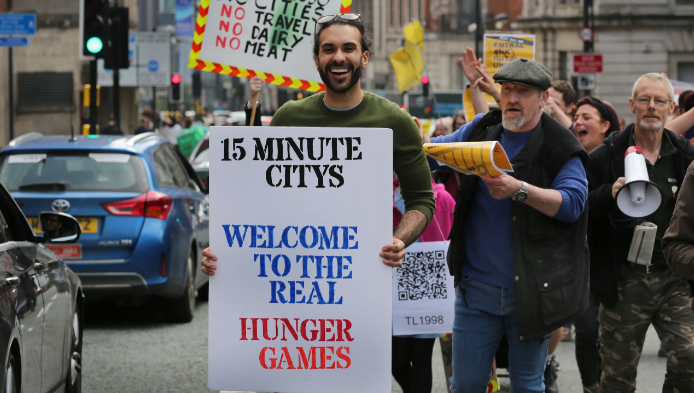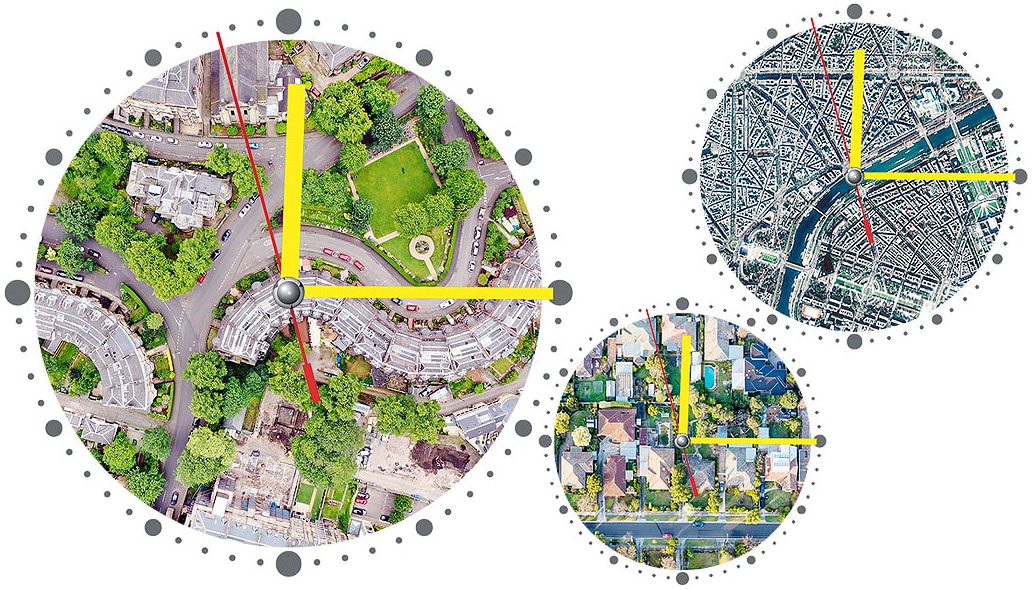Smart cities, 15-minute cities and how we win
What exactly is a “smart city” and what does it have to do with a “15-minute city”? And what does all this have to do with personal freedom, and especially freedom of movement?

You’ve probably heard the term smart city or the newer term 15-minute city before, but do you really know what these concepts mean? Do you know which organizations are responsible for promoting these ideas? And more importantly, are you prepared to survive and thrive in the face of these freedom-hostile plans?
To prepare for a possible future emergency, we need to better understand what is coming. Let’s start by understanding what is meant when we talk about smart cities.
The term typically describes an urban area equipped with 5G (and soon 6G) towers that enable the speed and bandwidth needed for autonomous vehicles, robot assistants, and sensors in the streets to control street lighting and issue environmental alerts. All of this would be supported by artificial intelligence (AI). The totality of sensors, devices, and infrastructure is known as the Internet of Things (IoT).
In simple terms, the IoT is a network of digital devices, vehicles, appliances, and other physical objects equipped with sensors that allow them to collect and share data. This real-time data collection is central to smart city initiatives that aim to serve as a springboard to a digital utopia. The devices connected to the IoT range from smartphones to smart appliances to smart homes or buildings with smart thermostats. Even wearables such as smartwatches, earbuds, and fitness equipment are part of the IoT. A simple rule of thumb is that if a device is labeled as smart or has Wi-Fi or Bluetooth capabilities, it can be connected to the IoT.
National Geographic describes a smart city as “a city that deploys a range of sensors (typically hundreds or thousands) to collect electronic data from and about people and infrastructure, improving efficiency and quality of life.” NatGeo points out that residents and city employees may need to use apps to access city services, receive and submit reports of outages, accidents and crimes, pay taxes and fees, etc. They also highlight the potential use cases for reducing energy consumption and improving a city’s sustainability.
Overall, smart cities are sold to the public as a futuristic cityscape with features like street lights that automatically turn off when no one is around or AI algorithms that optimize garbage collection routes. We are also told that by combining AI with sensors and cameras, we will have autonomous or driverless vehicles everywhere, which will ease traffic congestion.
Unfortunately, the vision of a smart city is in reality another step towards the loss of our civil liberties and our privacy.
In April 2018, the American Civil Liberties Union published a guide that outlines key questions that city governments seeking to join the smart city movement should be asking. The guide, titled How to Prevent Smart Cities from Turning to Surveillance Cities, was written by Matt Cagle, an attorney with the American Civil Liberties Union of Northern California. In January 2019, Mr. Cagle commented on the growth of smart cities and the technology behind them. Here is what he said:
“When we talk about smart city technology or the Internet of Things in a government context, we are really talking about electronics that are perhaps small and cheap and can be placed around the city to collect information, be it visual or acoustic information or information about whether a parking space is occupied. However, before acquiring or deploying a smart city technology, a city must decide together with its population whether this technology really makes sense for the city.
Smart city technology can be a wolf in sheep’s clothing. It can be another way for the government to collect information that it may not have intended to collect for law enforcement purposes but that may be vulnerable to that type of use later, or that it may not have intended to collect for immigration purposes but that may be vulnerable to those uses later. And again, that technology is often collected by companies that developed it. So it’s really important for the city and the community to be on the same page about who’s going to own that data as we move forward with this project, who’s going to be able to sell that data, and whether communities are going to have control over these technologies at the end of the day.”
Not only are smart cities a privacy nightmare, but if city planners have their way, you may soon not be able to drive a car without paying a toll or be fined for crossing the street due to ubiquitous facial recognition cameras.
What is a 15-minute city?
This brings us to the concept of 15-minute cities. First introduced by an urban planner named Carlos Moreno at the United Nations Climate Change Conference in 2015, the concept of 15-minute cities is essentially based on the idea that all resources in a community should be within a 15-minute walk.

As with most ideas promoted by the United Nations, this doesn’t sound so terrible on its own. Who wouldn’t want to be able to walk to get their groceries, or to the local community center? Some of you may even already live in areas where everything is within 15 minutes. So what’s the problem, you may ask?
Well, if you look beyond the buzzwords, you can see that 15-minute cities, much like smart cities, have the potential to be used as a means of restricting freedom of movement and speech, as well as privacy. Many people also fear that concepts like smart cities and 15-minute cities are really about getting people to stop driving their own cars (all in the name of the climate, of course). A brand new book by Carlos Moreno claims to offer “techniques to change the habits of car-dependent urban dwellers.” It doesn’t get any clearer than that.
Moreno has succeeded in bringing his idea into the mainstream: Paris, France, was the first to adopt the idea in 2020. But it was not until late 2022 and early 2023 that opposition to 15-minute cities became a public issue. In February 2023, an estimated 2,000 demonstrators gathered in central Oxford, England, to protest against the creation of a so-called Low-Traffic Neighbourhood (LTN).
To implement the LTN, Oxford authorities decided to introduce six traffic filters that will restrict car traffic in residential areas of the city at certain times. Cameras with automatic number plate readers will scan license plates to penalize motorists from outside Oxfordshire who enter these areas at busy times.
Of course, the media has done its best to label opponents of 15-minute cities as far-right conspiracy theorists. However, due to pressure from residents and international attention, Oxford City Council recently decided to remove mention of 15-minute cities from its city planning documents. While the council voted to remove the term from the documents, it made it clear that it still wants to stick to its vision of a walkable city with restrictions on private transport. Louise Upton, Oxford City Council’s cabinet member for planning, told the Times that removing the phrase would have “no significant impact on our planning decisions.”
Oxford is not the only city to take measures to impose driving bans or use digital technologies to track citizens’ behavior. Officials in a Canadian municipality recently decided that tourists must pay 30 Canadian dollars to receive a QR code that allows them to enter or leave the Îles-de-la-Madeleine archipelago. The more than 12,000 residents must show their driving license when entering and leaving the country.
In 2022, Venice (Italy) introduced a similar policy by announcing that it would charge a fee to tourists who visit the historic canals for just one day. The measure is said to be a response to the notorious tourism that is flooding the region. While the fee is only about $6 and is only charged on the 29 busiest days of the year, visitors need to register and receive – once again – a QR code via a smartphone. This seems to be yet another way to lock people in the digital prison that is being built around humanity.
The World Economic Forum and the United Nations
It should come as no surprise that the WEF and the United Nations are two of the biggest proponents of the 15-minute city and smart city projects. In October 2019, the WEF and the G20 countries launched the G20 Global Smart Cities Alliance on Technology Governance.
The Smart Cities Alliance website states that the alliance “sets and advances global policy standards to accelerate best practices, mitigate potential risks, and promote greater openness and public trust.” The alliance says it represents more than 200,000 cities and local governments, as well as businesses, start-ups, research institutions, and civil society communities.
The WEF also reminds us that the push toward 15-minute smart cities is designed to achieve the United Nations Sustainable Development Goal 11, which aims to make cities and human settlements “inclusive, safe, resilient and sustainable.” In the interest of this goal (and the rest of the UN SDGs), cities are working to adopt a range of so-called smart technologies. These technologies and concepts are designed to enclose people in tightly controlled, tracked and traceable urban environments.
What is the solution?
As these technocrats meet day and night to plan their near-future dystopia for humanity, we need to ask ourselves what we are doing to plan our future. If humanity is to chart its own course, we can no longer allow these criminals to lead us gently into techno-tyranny.
One aspect everyone can do is ask themselves what they would do if their town required a QR code or digital ID to enter the grocery store? Or maybe the local hospital? As we’ve seen during the covid crisis, your business might require a digital ID to get paid, and your bank might require it to cash the check.
If your workplace or city requires vaccination or PCR testing, it is likely that they will introduce similar measures in the near future. Having a plan for how you will navigate these difficult situations is an absolute must. Talk to your family, friends, neighbors, etc. Imagine these scenarios and ask each other how you can support each other in these situations.
Another important component of thriving in the face of increasing tyranny is community. Again, this could be your immediate family, your activist circle, your neighbors, coworkers. The point is, we all need a support network to get through the times. We need networks to exchange food, services, seeds, skills, and other goods that don’t require injections, QR codes, digital IDs, or other invasive measures.
If you find yourself lacking community, use Freedom Cell Network website to search the maps for people and groups in your area. Meeting in person will always be better than digital connections.
Whatever you do, it’s imperative to spread this information as widely as possible and start planning for the future. The future generations are counting on us to step up and make a decision. They’re counting on us to leave them a better, freer world.
It’s time for us to stand together. It’s time to get out and build.
yogaesoteric
May 30, 2024
Also available in:
 Română
Română
